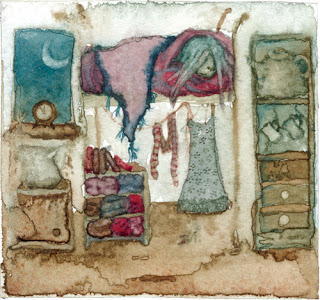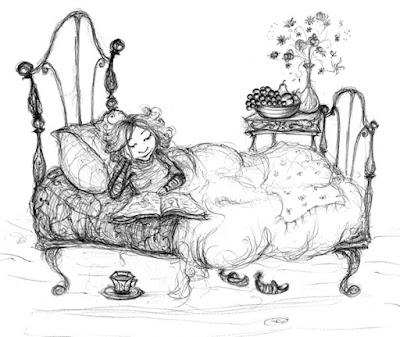
Ice dragons (Draconis borealis) inhabit the far north and live on elves and flying deer. When they display, either to frighten encroachers or find a mate, they send vast plumes of freezing flame into the sky, which we call the Aurora Borealis, or Northern Lights.
Unlike dragons in temperate regions, which hoard gold, ice-dragons treasure the feldspar stones - labradorite, spectrolite, and moonstone if they can get it, which they generally can't. An Eskimo legend has it that these stones were formed when flickers of Aurora Borealis got trapped in rock. Moonstones, usually found far from the poles, caught their flames long ago when the world was otherwise arranged. Polar explorers wary of dragons often take moonstones with them as propitiatory gifts.
Some people believe the Southern Lights (Aurora Australis) are also caused by dragons but of course this is nonsense - the Southern Lights are a result of the Earth's magnetic field interacting with particles flung out by the Sun. (Either that, or they are the energy released when phoenixes hatch from their opals.)
Unlike dragons in temperate regions, which hoard gold, ice-dragons treasure the feldspar stones - labradorite, spectrolite, and moonstone if they can get it, which they generally can't. An Eskimo legend has it that these stones were formed when flickers of Aurora Borealis got trapped in rock. Moonstones, usually found far from the poles, caught their flames long ago when the world was otherwise arranged. Polar explorers wary of dragons often take moonstones with them as propitiatory gifts.
Some people believe the Southern Lights (Aurora Australis) are also caused by dragons but of course this is nonsense - the Southern Lights are a result of the Earth's magnetic field interacting with particles flung out by the Sun. (Either that, or they are the energy released when phoenixes hatch from their opals.)

 This might be why so many people dislike the daylight savings arrangement. It doesn't really save any daylight, it just makes it dark earlier. We should just accept that there is less daylight, and agree among each other that in the winter we are only expected to be awake and contactable for, say, four hours instead of eight.
This might be why so many people dislike the daylight savings arrangement. It doesn't really save any daylight, it just makes it dark earlier. We should just accept that there is less daylight, and agree among each other that in the winter we are only expected to be awake and contactable for, say, four hours instead of eight.
 Of course, apart from all these things, it's still worthwhile to get out of bed in the winter, providing it's decently light out. For one thing there is the way trees turn into patterns of intricate lacework. And there is the intriguing notion of everything being stored away till next year; bats and butterflies and crocus-bulbs, packed away like summer clothes. Andrew Wyeth described it perfectly:
Of course, apart from all these things, it's still worthwhile to get out of bed in the winter, providing it's decently light out. For one thing there is the way trees turn into patterns of intricate lacework. And there is the intriguing notion of everything being stored away till next year; bats and butterflies and crocus-bulbs, packed away like summer clothes. Andrew Wyeth described it perfectly:


